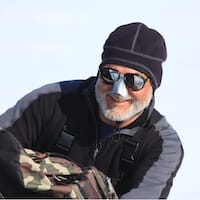
Research Professor
Electromagnetic Geophysics
Energy & Geoscience Institute, University of Utah
| 1994 - Present | Research Professor | University of Utah/EGI |
| 1983 - 1994 | Senior Scientist | University of Utah Research Institute |
| 1983 | Ph.D, Geophysics | University of Utah, Dept. of Geology and Geophysics |
| 1976 | B.Sc, Engr Geology | Queen’s University, Kingston, Canada |
| 2019 - Present | Member | IRIS Electromagnetic Advisory Committee (EMAC) |
| 2015 | Featured Graphic | Future Geophysics Facilities Report to NSF, U.S. Cascadia MT Resistivity Synthesis |
| 2013 | Presenter | Earthscope National Meeting, Workshop on MT TA Regional Site Selection (SE Appalachians chosen) |
| 2009 - 2010 | In-Field Coordinator | MT TA site selection, permitting and deployment, NW Intermontane region |
| 2007 - 2009 | Chair | IRIS/Earthscope Electromagnetic Working Group (EMWoG) |
| 2005 | Invited Reviewer | EM Induction studies, First Earthscope National Meeting |
| 1997 - 2007 | Scientist-in-Charge | EMSOC National Instrumentation Facility |
| 1994 - Present | Advisor/Funder | Twenty-Seven M.S., Ph.D and Post-Doctoral young professionals |
| 2016 | Invited Presenter | UNAVCO Workshop on Scientific Drivers and Future of Mount Erebus Volcano Observatory (MEVO), Antarctica |
| 2014 | Co-Author | Seminal interpretation paper on Pacific North-West MT USArray 3D structure |
| 2011 | Fellow | Geological Society of America |
| 2011 | Attendee | Earthscope-GeoPRISMS Science Work-shop on Eastern North America (ENAM) |
| 2006 | Attendee | Earthscope Workshop on Integrated Geologic Framework for USArray |
| 1998 - 2002 | Review Panelist | National Science Foundation/Earth Sciences Division/Continental Dynamics |
| 1991 - 2005 interim | Associate Editor | Journal of Geophysical Research, Pure and Applied Geophysics, Geophysics |
STATEMENT
The IRIS and UNAVCO communities are broadening their scientific and educational visions both through the advancement of cutting-edge technologies and concepts and by the integration of larger and more diverse data sets, as part of their plan to merge and become the EarthScope Consortium. Exemplifying this new era is a substantial pool of portable magnetotelluric (MT) systems being established at the PASSCAL Instrument Center (PIC). This EM method offers unique multi-scale views of fluid, thermal and other petrological/geochemical Earth processes. The next few years will see competitive selection of instrumentation products, and incorporation of the MT pool within the PIC including project logistical support nationally and internationally. Effective synthesis is crucial to ensure education of Earth scientists both as MT specialists and as integrative practitioners. We must expand our vision for the potential of the method whether as an individual technique or in cooperative investigations with seismology and broader geoscience.
The breadth of my interests, collaborations and accomplishments are an advantage for serving on the IRIS Board of Directors. These include seminal advances in multidimensional MT model computation, planning and execution of major field campaigns both in the U.S. and internationally, and multi-disciplinary relationship of resistivity structure to physico-chemical state in the Earth. Our research group at Utah in particular pioneered collection capability for high-fidelity MT data over polar ice sheets leading to several international collaborations in Antarctica illuminating orogenic processes and volcanogenic architecture. I also offer a substantial bridge to green energy research in the burgeoning geothermal field, where EM methods are a primary resource evaluator. Transitions in institutional resources for U.S. geophysics over the next several years need careful handling for the sake of our new generations of Earth scientists. It is an honor to stand for election to this important position.